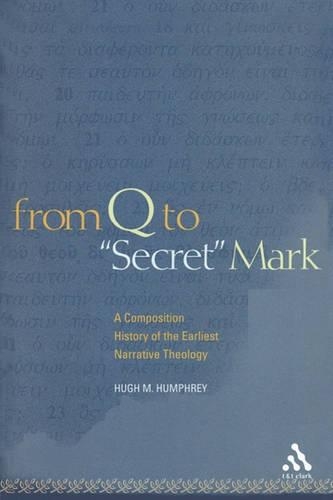
From Q to "Secret" Mark: A Composition History of the Earliest Narrative Theology
(Paperback)
Publishing Details
From Q to "Secret" Mark: A Composition History of the Earliest Narrative Theology
By (Author) Hugh M. Humphrey
Bloomsbury Publishing PLC
T.& T.Clark Ltd
1st June 2006
United Kingdom
Classifications
Professional and Scholarly
Non Fiction
226.3066
Physical Properties
Paperback
176
272g
Description
The literary complexity and the theological nuances of the Gospel of Mark did not spring from the evangelist's pen at a single sitting. The evangelist we call "Mark" composed segments of our present gospel for different situations, over an extended period of time, perhaps several decades, and that the present text reflects the mature, spiritual reflection on the nature of discipleship. In this provocative book, Humphrey challenges the traditional view that Mark was simply an editor drawing together different sources to put together his gospel. In order to establish this thesis about the manner in which Mark was composed, Humphrey first reviews the patristic witness to the gospel, pointing out the ambiguities and tensions between them. He gives particular emphasis to Clement of Alexandria, who specifically indicates that Mark wrote several different works. Following that chapter, Humphrey describes two major segmentsreally two different compositionsof Mark. It is clear, he argues, that there was a narrative version of the "Q" tradition, that collection of sayings that has been viewed as an oral tradition, as well as a "Passion Narrative" in Mark. A third stage of the composition of Mark occurs when Q and the Passion Narrative are blended and an emphasis upon discipleship is interwoven into the text. The deeper theological reflection reflected in this third development yielded what Mark called the "mystery of the Kingdom of God" (4:11) and what Clement of Alexandria calls Mark's "secret gospel." Humphrey focuses on distinguishing the narrative interests that disclose the ultimate righteous teacher of God's Kingdom (Son of God), the suffering Christ, and the lessons for discipleship. The gospel of Mark results not from an editor working on unattested documents but on the ever-maturing theological reflection of "Mark." Humphrey's study has two purposes. If theology is the process of bringing faith to expression, then that process is illustrated in the composition history of Mark's gospel. Each stage of composition expresses an aspect of the early Christian faith response to God's having raised Jesus from the dead. Second, this reconstruction of Mark's gospel serves to highlight the talent and depth and personality of its author as well as to point out that the handling of traditions about Jesus in this way provides a useful paradigm for the Church today.
Reviews
"Hugh M. Humphrey writes with freshness and panache..." -- Church Times
"The argument is lucid, internally coherent and succinct." F. Gerald Downing JSNTS Booklist, 2007 -- F. Gerald Downing
Review in The Journal of Theological Studies, Vol 59, no 1, April 2008
Humphrey says Mark first compiled Peter's preaching of the Q material, expanding it into a narrative (chapters one to thirteen) portraying Jesus as the Son of God inspired by Wisdom, the eschatological Teacher. This he did while Peter was preaching in Rome. Later he narrated Peter's preaching of the cross, creating the Passion Narrative. It was "Pauline" in its Christology of a self-emptying Son of Man/Adam. This was on the eve of Claudius's expulsion of Jews from Rome. Taking both texts to Alexandria, Mark decided to unite the two texts, seeding each half with new materials recalling or foreshadowing the other, adding the theme of discipleship in a world not likely to end as soon as he had first expected... Markan specialists should be sure to read it. Robert M. Price Johnnie Colemon Theological Seminary * Religious Studies Review *
Author Bio
Hugh M. Humphrey is Professor of Religious Studies at Fairfield University and is the author of "He Is Risen!": A New Reading of Mark's Gospel.
